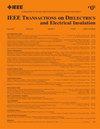绝缘油中电气操纵的水积累:来自分子动力学模拟的见解
IF 3.1
3区 工程技术
Q2 ENGINEERING, ELECTRICAL & ELECTRONIC
IEEE Transactions on Dielectrics and Electrical Insulation
Pub Date : 2025-03-20
DOI:10.1109/TDEI.2025.3571384
引用次数: 0
摘要
为了减少电气设备中水的潜在威胁,研究电气操作下绝缘油中水积聚的机理至关重要。本研究利用分子动力学方法建立油水混合模型,定量探讨不同电场作用下水团簇的动态演化。关键发现表明,在直流(dc)电场下,极性水分子与电场对齐。当直流电场强度(${E} _{\text {dc}}$)低于0.50 V/nm时,水分子之间的相互作用增强,导致聚集更紧密,成核和生长速度加快。随着${E} _{\text {DC}}$的增大,极化加剧,增强了油水相互作用,限制了水的迁移,抑制了新的成核。现有液滴拉伸和生长迅速,内部密度降低,导致结构不稳定。在交流电场下,水分子的取向会周期性地调整。电场振幅$\text {(}{E}_{{0}}\text{)}$低于0.50 V/nm时,弱极化和去极化效应降低了水分子的迁移。然而,更强的分子间吸引力使分子聚集更紧密,导致碰撞频率增加,从而提高成核和生长速度。因此,形成的水团倾向于在电场中心附近盘旋。当${E}_{{0}}$超过0.50 V/nm时,更强的周期性极化增强了聚集,导致运动更剧烈,形成更大、更稳定的液滴。相对而言,交流电场表现出更强的动态调控,加速了水分子的聚集和成核,特别是在${E}_{{0}}=2.00$ V/nm时。这项研究为电气设备中水的动态行为提供了关键的见解。本文章由计算机程序翻译,如有差异,请以英文原文为准。
Electrically Manipulated Water Accumulation in Insulating Oil: Insights From Molecular Dynamics Simulations
To reduce the potential threat of water in electrical equipment, it is crucial to study the mechanisms of water accumulation in insulating oil under electrical manipulation. This study established an oil-water mixture model using molecular dynamics (MDs) simulations to quantitatively explore the dynamic evolution of water clusters under different electric fields. Key findings indicate that under a direct current (dc) electric field, polar water molecules align with the field. At dc electric field strengths ( ${E} _{\text {DC}}$ ) below 0.50 V/nm, interactions between water molecules strengthen, leading to tighter aggregation and increased nucleation and growth rates. As ${E} _{\text {DC}}$ increases, polarization intensifies, enhancing oil-water interactions, restricting water mobility, and inhibiting new nucleation. Existing droplets stretch and grow rapidly, with reduced internal density, causing structural instability. Under an alternating current (ac) electric field, water molecule orientation adjusts periodically. At electric field amplitudes $\text {(}{E}_{{0}}\text {)}$ below 0.50 V/nm, weak polarization and depolarization effects reduce water molecule migration. However, stronger intermolecular attraction tightens molecular aggregation, leading to increased collision frequency, which subsequently enhances nucleation and growth rates. As a result, the formed water clusters tend to hover near the center of the electric field. As ${E}_{{0}}$ exceeds 0.50 V/nm, stronger periodic polarization enhances aggregation, resulting in more vigorous motion and the formation of larger, more stable droplets. Relatively speaking, the ac field shows stronger dynamic regulation, accelerating water molecule aggregation and nucleation, particularly at ${E}_{{0}}=2.00$ V/nm. This study provides key insights into the dynamic behavior of water in electrical equipment.
求助全文
通过发布文献求助,成功后即可免费获取论文全文。
去求助
来源期刊
CiteScore
6.00
自引率
22.60%
发文量
309
审稿时长
5.2 months
期刊介绍:
Topics that are concerned with dielectric phenomena and measurements, with development and characterization of gaseous, vacuum, liquid and solid electrical insulating materials and systems; and with utilization of these materials in circuits and systems under condition of use.

 求助内容:
求助内容: 应助结果提醒方式:
应助结果提醒方式:


